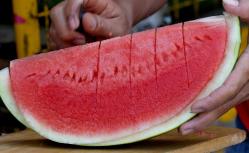With the possible exception of the tomato, no item of fresh produce varies as widely in quality as the watermelon. Who among us has not at some point bitten into a pallid pink chunk from a fruit salad and found one’s tongue coated in a repellent mealy paste that no amount of chugged water can erase the memory of? Then again, who among us has not from time to time devoured a wedge of astonishingly sweet, overwhelmingly juicy, ruby-red melon flesh?
Yet despite the enormous gratification that a slice of ripe seasonal watermelon can provide—especially when at a picnic or barbecue among friends amenable to a seed-spitting contest—plain watermelon leaves something to be desired. To be fair, it does not leave much to be desired. But both its unbeatably succulent texture and its cloyingly sweet flavor cry out to be anchored by something substantial, the way Beirut’s heavy instrumental arrangements anchor Zachory Condon’s syrupy, droning voice.
Watermelon was first cultivated in ancient Egypt, and the best way to eat it was discovered by people living just across the sea from the fruit’s original home. If you want to make excellent watermelon taste even better, serve it like they do in many Mediterranean countries, including Greece, Turkey, and Israel: with feta.
If you were trying to design the ideal ingredient to complement watermelon, you’d probably come up with something very similar to feta cheese: creamy and dense where watermelon is watery and crunchy—and also salty enough to stand up to the fruit’s intense sugariness. The combination of feta and watermelon needs literally nothing else: no salt, no pepper, no salad dressing. Some versions of this recipe call for slivers of red onion, but it’s too sharp in this context (particularly when served for breakfast, as watermelon and feta traditionally are). You can add a handful of roughly torn fresh mint, basil, or parsley leaves if you want the color contrast or the mild herbal flavor, but that is entirely optional. (I almost always leave it out.)
In a two-ingredient recipe, ingredient quality matters even more than usual. Choose a heavy, dark green watermelon with a blotch of yellow on one side (the yellow indicates that it was ripened adequately on the vine). Seedless watermelon is widely considered inferior in flavor to the kind with seeds, but the latter is hard to come by these days, so take what you can get. As for the cheese: Country and animal of origin don’t matter—any white brined cheese will do. But you must buy it in brick form and crumble it yourself: The pre-crumbled feta sold in plastic tubs contains additives and has a drier, grainier texture than brine-packed feta.
The idea of eating watermelon with feta often surprises—and sometimes offends—those who have never heard of it, but I’ve yet to meet anyone who dislikes it after giving it a try. Start eating watermelon this way, and you won’t be able to stop. (I speak from experience.) If you want to get your fix before watermelon season—good watermelon season—is over, try it soon.
Watermelon and Feta Salad
Yield: 4 servings
Time: 10 minutes
¼ large watermelon, cut into 1-inch chunks
2 ounces feta cheese, crumbled
If the watermelon contains black seeds, remove and discard as many of them as you reasonably can. Put the watermelon and feta in a salad bowl and toss to combine. Serve immediately.
Previously in You’re Doing It Wrong:
Banana Pudding
Popcorn
Green Beans
Gazpacho
Pie
Zucchini
Brussels Sprouts
